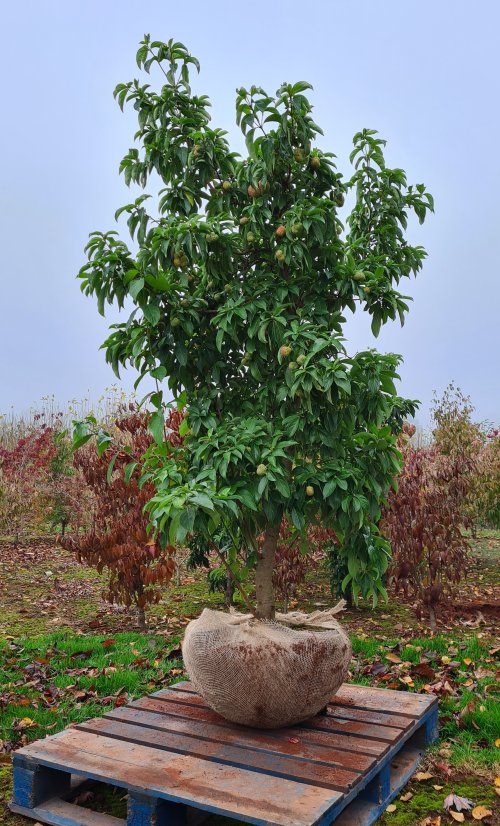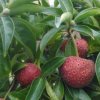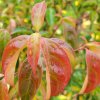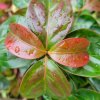
CORNUS...
last updated 18/11/2023
|
We
have a number of flowering dogwoods in the collection which are
evergreen. There is considerable uncertainty and confusion surrounding
the classification of many of them as to exactly which species they
belong too. However, the important thing is that they all follow the
same principle as our deciduous flowering dogwoods, in that they produce
beautiful bracts surrounding the tiny true flowers in summer, typically
providing floral interest from June potentially through into August or
even September,
dependant a little on the weather. Many of them then go on to give
similar strawberry-like fruit. Since these are fully evergreen, the
leaves don't change colour in the autumn. Instead we can enjoy the often
glossy foliage all winter. These are all fundamentally hardy in most of
the UK, but as with any evergreen, they can be vulnerable to desiccating
wind if the ground is frozen. Thus they will be tolerant of an open site
in milder locations, but shelter from the coldest wind will be valuable
further north or east. I would expect them to grow happily in shade, but
to flower more profusely in a warm sunny site. |
Cornus
elliptica 'Full Moon' |
This photo, taken in early November, shows a specimen of Cornus elliptica 'Full Moon' that has just been lifted from the open ground. The rootball has been wrapped in hessian to protect it. This will be planted exactly as it is, leaving the hessian in place. The hessian is untreated so will break down in the soil very quickly. |
|
|
||
| Cornus capitata | Cornus
capitata Cornus capitata is a classic species from the Himalayas and China, being until comparatively recently the only evergreen bracting Cornus commonly found in cultivation. As is typical in this group the bracts are at their best in July, and are followed by large, juicy, strawberry-like fruit to round-off the display in the autumn. Cornus capitata has the potential to form a broad tree, with a rounded head. Traditionally it has been considered to need a sheltered site, but climate change seems to be making it more accessible to a wider range of locations. |
|
|
|
||
| Cornus
capitata 'Kilmacurragh Rose' This fabulous Irish selection from Wicklow resembles the species in most characteristics. However it is distinguished by the bracts, which whilst opening to the usual cream, then mature to a wonderful shade of rosy pink. |
||
|
|
||
| Cornus elliptica | Cornus
elliptica 'First Choice' We are grateful to Mark Weathington at JCRA for sharing this one with us. This one has a paler bronze flush to the thickly textured, glossy leaves than most members of the Summer Series described below. This is most pronounced on the young growth. The leaves also have a noticeably more glabrous underside, making them appear silvery, which gives a rather lovely contrast with the glossy uppers as the move in the wind. The creamy bracts in July are as you would expect for the group. 'First Choice' is very slow growing in our conditions, making what I would describe as a shrub rather than a tree. Although it clearly has the potential to become a lovely thing, unfortunately it does not do well in our conditions and as a result we seldom propagate it, preferring to focus on the other evergreens that we have that thrive for us. |
|
|
|
||
 |
Cornus
elliptica 'Full Moon' Simplest described as an evergreen equivalent of C. kousa with bright green, thickly textured leave that are held all through the winter. The bracts mature a little later though, so it is florally not at its peak until at least July. The creamy white bracts are huge, whilst the fruit which follow are massive by comparison to others in the group, often equalling or even exceeding the size of a golf ball. Since they are produced later in the season, they ripen to red later, so most effectively in a warm sunny site. Sturdy upright habit. We first acquired this one under the name Cornus angustata 'Full Moon', with C. angustata sometimes being classified as a subspecies of Cornus kousa. However, angustata is no longer considered to be a valid name, and it is currently attributed to Cornus elliptica. |
|
 |
||
|
|
||
| Cornus hongkongensis | Cornus
hongkongensis (previously listed as C. emeiensis) The limited information available about this one is conflicting. We obtained it originally as Cornus emeiensis. The RHS attributes C. emeiensis to C. capitata. Perhaps that is the case, but visually it is poles apart. Flora of China don't recognise C. emeiensis as a valid species, so it seems most likely that it should be classified under Cornus hongkongensis. The foliage of our C. hongkongensis is a warm copper colour, richest in the young growth, but largely maintained through the year. It has a wonderful dense, cascading habit, thus naturally making a large shrub rather than attaining the proportions of a tree. The "flowers" share the typical 4-bracted structure of the group, though they tend to remain smaller and more star-like than many, further enhancing the grace of the plant. The original plant of this species that I came across was in a large pot and although I would be more inclined to plant it in the garden in the normal way, it did make a very lovely specimen in a large container. See it in our Woodland Walk. |
|
|
|
||
|
||
|
|
||
.jpg) |
Cornus
'Summer Flair' My first impression of 'Summer Flair' is that it is one of the more vigorous selections in this group. The leaves are richly flushed with bronze when young, maturing to a bright, glossy green. It looks to be a beautiful plant. The picture left was taken in November. |
|
|
|
||
 |
Cornus
'Summer Glossy' This one has the darkest, most bronzey foliage of the four. The leaves are also narrower. It seems much slower growing than 'Summer Flair' and 'Summer Sky Tree', but it looks as though it is going to make a very beautiful shrubby small tree of compact habit. The photo left was taken in November. |
|
|
|
||
| Cornus
'Summer Passion' Also slower growing, the foliage of 'Summer Passion' is slightly paler than that of 'Summer Glossy'. At this early stage, it is looking to be a little laxer in habit than 'Summer Glossy' but it will be interesting to see how they compare as they mature. |
||
|
|
||
 |
Cornus
'Summer Sky Tree' Based on the name, I am assuming that this one will be the tallest and most upright, with the potential to make a tree of good height. Certainly early signs are that it has good vigour. Its foliage is the greenest in the group, still sumptuously glossy, but with only a hint of the bronzey young growth. |
|
|
|
||
| Back to Previous Page |